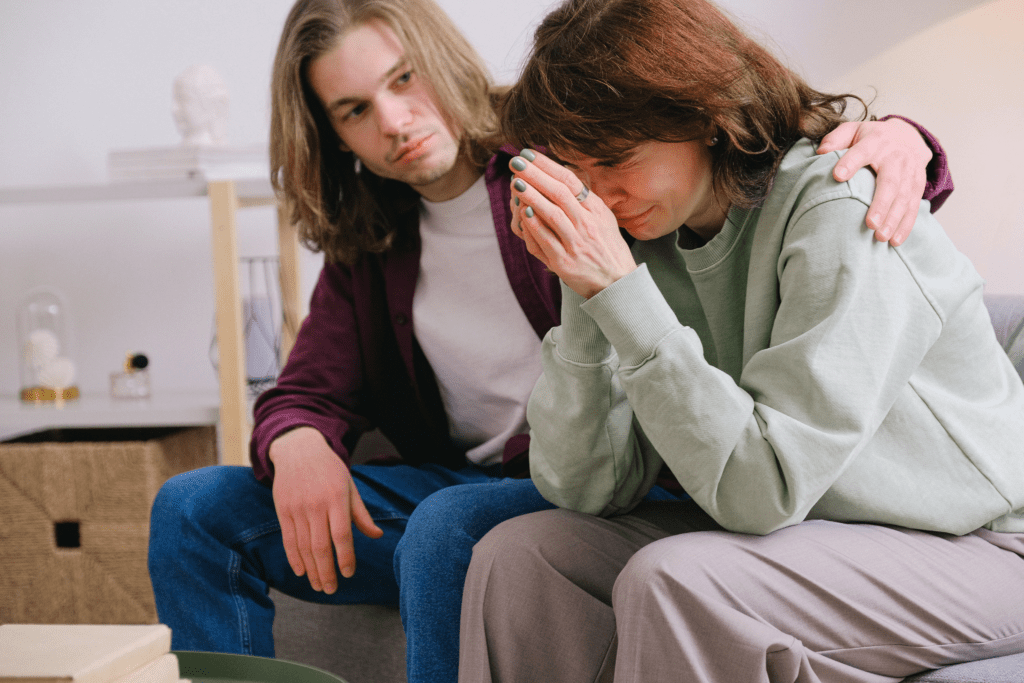Last updated on December 18th, 2024 at 03:28 am
- 1. The Nature of PTSD
- 1.1 PTSD Symptoms
- 1.2 Risk Factors for PTSD
- 2. The Intersection of PTSD and Substance Use Disorders
- 2.1 Prevalence of Comorbidity
- 2.2 Shared Vulnerabilities
- 2.3 Self-Medication Hypothesis
- 3. The Impact of Co-occurring PTSD and SUDs
- 3.1 Symptom Exacerbation
- 3.2 Functional Impairment
- 3.3 Treatment Challenges
- 4. Evidence-Based Treatment Approaches
- 4.1 Integrated Treatment Models
- 4.2 Trauma-Focused Therapies
- 4.3 Pharmacological Interventions
- 5. The Importance of Comprehensive Care
- 5.1 Trauma-Informed Care
- 5.2 Addressing Co-occurring Mental Health Conditions
- 5.3 Social Support and Skill Building
- 6. Special Populations and Considerations
- 6.1 Veterans and Military Personnel
- 6.2 Survivors of Childhood Trauma
- 6.3 Women with PTSD and SUDs
- 7. Prevention and Early Intervention
- 7.1 Trauma-Informed Practices
- 7.2 Screening and Assessment
- 7.3 Resilience Building
- 8. Future Directions in Research and Treatment
- 8.1 Neurobiological Research
- 8.2 Personalized Medicine Approaches
- 8.3 Technology-Assisted Interventions
- PTSD and Complex Interplay with Addiction
- Risk Factors for Substance Abuse and PTSD
- Military Personnel and PTSD
- Emotional and Physical Abuse as Trauma Risk Factors
- Sexual Violence and Substance Abuse
- The Impact of Domestic Violence
- Adverse Childhood Experiences and Long-term Effects
- Negative Consequences and Comorbidity
- Adolescent Substance Abuse and Trauma
- Co-occurring Disorders in Clinical Populations
- Hyperarousal Symptoms and Self-Medication
- African Americans and PTSD Prevalence
- Emotional Pain and the Use of Substances
- PTSD and Prescription Drug Misuse
- Trauma and Alcohol Dependence
- Long-Term Recovery and Dual Diagnosis Treatment
- Influence of Child Abuse on Adult Dependence
- Psychiatric Patients and Trauma Comorbidity
- Trauma Symptoms and Healthcare Providers’ Role
- Medical Condition and Adverse Life Events
- Trauma-Related Addiction Behaviors and Compulsive Substance Use
- Substance Use Disorders in PTSD Patients
- PTSD and Synthetic Drug Use
- Influence of Trauma on Mental Health Outcomes
- Connection Between PTSD and Substance Misuse
- Adolescents with Trauma and Alcohol Use Disorder
- Withdrawal Symptoms in Dual Diagnosis
- Role of Healthcare Providers in Trauma-Induced Substance Use
- Co-occurring PTSD and Substance Abuse
- PTSD and Cocaine Addiction in Civilian Population
- Domestic Violence as a Trauma-Related Risk Factor
- PTSD and Recreational Drug Use in Community Sample
- Substance Abuse as PTSD Coping Mechanism
- Emotional Abuse and Its Effects on Substance Use
- Frequently Asked Questions
- How Does Combat Exposure Increase the Risk of PTSD and Addiction?
- What Are the Connections Between PTSD and Substance Abuse in Sexual Assault Survivors?
- How Does Childhood Trauma Influence the Development of PTSD and Addiction?
- Why Are Military Veterans at a Higher Risk of Co-Occurring PTSD and Substance Use Disorders?
- How Do Natural Disasters Contribute to PTSD and Substance Abuse?
- What Is the Relationship Between Domestic Violence, PTSD, and Addiction?
- How Does Sexual Violence Increase the Risk of PTSD and Addiction in Women?
- What Role Does Emotional Abuse Play in PTSD and Substance Abuse?
- How Does PTSD from Childhood Trauma Affect Adult Substance Use?
- What Are the Effects of Childhood Sexual Abuse on PTSD and Addiction?
- How Do PTSD Symptoms Like Hyperarousal Lead to Substance Abuse?
- Why Is Substance Use Common Among PTSD Patients Who Have Experienced Physical Abuse?
- What Are the Risk Factors for Developing Both PTSD and Addiction After a Natural Disaster?
- How Does Complex PTSD Differ from PTSD in Terms of Substance Abuse Risk?
- What Role Do Healthcare Providers Play in Treating Co-Occurring PTSD and Substance Use Disorders?
- How Does PTSD from Military Combat Lead to Substance Use in Veterans?
- How Does Adolescent Trauma Influence the Development of PTSD and Substance Use?
- What Is the Impact of Negative Beliefs on PTSD and Substance Abuse?
- How Does Sexual Abuse in Childhood Lead to PTSD and Later Substance Use?
- Why Is Dual Diagnosis Treatment Important for PTSD and Addiction Recovery?
Post-traumatic stress disorder (PTSD) and substance use disorders (SUDs) frequently co-occur, creating a complex and challenging situation for those affected.
Understanding the intricate relationship between trauma, PTSD, and addiction is crucial for developing effective treatment approaches and supporting individuals on their path to recovery.
1. The Nature of PTSD
PTSD is a mental health condition that can develop after experiencing or witnessing a traumatic event. While exposure to trauma is common, only a subset of individuals go on to develop PTSD. The disorder is characterized by a cluster of symptoms that significantly impact daily functioning and quality of life.
1.1 PTSD Symptoms
PTSD symptoms typically fall into four main categories:
- Intrusive thoughts: Recurring, unwanted memories of the traumatic event, nightmares, and flashbacks
- Avoidance: Efforts to avoid reminders of the trauma, including places, people, or activities
- Negative changes in cognition and mood: Persistent negative emotions, distorted beliefs about oneself or others, and feelings of detachment
- Alterations in arousal and reactivity: Heightened startle response, difficulty concentrating, irritability, and sleep disturbances
1.2 Risk Factors for PTSD
Several factors can increase an individual’s likelihood of developing PTSD after trauma exposure:
- Previous traumatic experiences, especially in childhood
- Family history of mental health disorders
- Lack of social support following the traumatic event
- Ongoing life stressors
- Personal history of anxiety or depression
2. The Intersection of PTSD and Substance Use Disorders
The co-occurrence of PTSD and SUDs is well-documented, with research indicating a strong bidirectional relationship between the two conditions.
2.1 Prevalence of Comorbidity
Studies have shown that individuals with PTSD are at a significantly higher risk of developing SUDs compared to the general population. Conversely, those with SUDs are more likely to have experienced trauma and develop PTSD. This mutual relationship creates a complex cycle that can be challenging to break without professional intervention.


2.2 Shared Vulnerabilities
Several factors contribute to the high comorbidity rates between PTSD and SUDs:
- Neurobiological changes: Trauma can alter brain structures and neurotransmitter systems, increasing vulnerability to both PTSD and addiction
- Genetic predisposition: Certain genetic factors may increase susceptibility to both disorders
- Environmental influences: Childhood adversity and chronic stress can contribute to the development of both conditions
2.3 Self-Medication Hypothesis
One prevalent theory explaining the link between PTSD and SUDs is the self-medication hypothesis. This theory suggests that individuals with PTSD may turn to substances as a means of coping with distressing symptoms. While substances may provide temporary relief, they ultimately exacerbate PTSD symptoms and create additional problems.
3. The Impact of Co-occurring PTSD and SUDs
The presence of both PTSD and SUDs can significantly complicate the recovery process and lead to poorer outcomes if not addressed comprehensively.
3.1 Symptom Exacerbation
Substance use can intensify PTSD symptoms, particularly those related to hyperarousal and avoidance. Conversely, PTSD symptoms can trigger cravings and increase the risk of relapse for individuals in recovery from SUDs.
3.2 Functional Impairment
Co-occurring PTSD and SUDs can lead to significant impairments in various life domains, including:
- Occupational functioning
- Interpersonal relationships
- Physical health
- Financial stability
- Legal issues
3.3 Treatment Challenges
The presence of both disorders can complicate treatment efforts, as each condition may interfere with the recovery process of the other. Traditional approaches that focus solely on one disorder may be insufficient for addressing the complex needs of individuals with co-occurring PTSD and SUDs.


4. Evidence-Based Treatment Approaches
Effective treatment for co-occurring PTSD and SUDs requires an integrated approach that addresses both conditions simultaneously.
4.1 Integrated Treatment Models
Several evidence-based treatment models have been developed specifically for individuals with co-occurring PTSD and SUDs:
- Seeking Safety: A present-focused therapy that addresses both PTSD and substance use through skill-building and psychoeducation
- Concurrent Treatment of PTSD and Substance Use Disorders Using Prolonged Exposure (COPE): Combines prolonged exposure therapy for PTSD with cognitive-behavioral therapy for SUDs
- Integrated Cognitive Behavioral Therapy (ICBT): Addresses both disorders through cognitive restructuring, coping skills training, and relapse prevention strategies
4.2 Trauma-Focused Therapies
Evidence-based trauma-focused therapies can be adapted for individuals with co-occurring SUDs:
- Cognitive Processing Therapy (CPT): Helps individuals challenge and modify unhelpful beliefs related to the trauma
- Prolonged Exposure (PE) Therapy: Involves gradual, controlled exposure to trauma-related memories and situations
- Eye Movement Desensitization and Reprocessing (EMDR): Utilizes bilateral stimulation to process traumatic memories
4.3 Pharmacological Interventions
Medication can play a crucial role in managing symptoms of both PTSD and SUDs:
- PTSD medications: SSRIs, SNRIs, and prazosin for nightmares
- SUD medications: Naltrexone, acamprosate, and buprenorphine, depending on the substance of abuse
5. The Importance of Comprehensive Care
Addressing co-occurring PTSD and SUDs requires a holistic approach that goes beyond traditional treatment modalities.


5.1 Trauma-Informed Care
Implementing trauma-informed care principles across all aspects of treatment is essential for creating a safe and supportive environment for recovery. This approach recognizes the widespread impact of trauma and integrates knowledge about trauma into policies, procedures, and practices.
5.2 Addressing Co-occurring Mental Health Conditions
Many individuals with PTSD and SUDs also experience other mental health conditions, such as depression, anxiety, or personality disorders. Comprehensive treatment should assess for and address these co-occurring conditions as part of the overall treatment plan.
5.3 Social Support and Skill Building
Developing a strong support network and acquiring coping skills are crucial components of recovery. Treatment programs should incorporate elements such as:
- Family therapy
- Peer support groups
- Life skills training
- Vocational rehabilitation
6. Special Populations and Considerations
Certain groups may face unique challenges when dealing with co-occurring PTSD and SUDs, requiring tailored approaches to treatment.
6.1 Veterans and Military Personnel
Military service members and veterans are at increased risk for both PTSD and SUDs due to combat exposure and the challenges of reintegration into civilian life. Treatment approaches for this population should address military-specific trauma and the unique cultural aspects of military service.
6.2 Survivors of Childhood Trauma
Individuals with a history of childhood trauma may experience complex PTSD, which can present additional challenges in treatment. Approaches for this population should focus on addressing attachment issues, emotional regulation, and interpersonal difficulties.


6.3 Women with PTSD and SUDs
Women with co-occurring PTSD and SUDs often have distinct needs and may benefit from gender-specific treatment approaches. These may include addressing issues related to sexual trauma, parenting concerns, and the unique physiological effects of substance use in women.
7. Prevention and Early Intervention
Efforts to prevent the development of PTSD and SUDs, as well as early intervention strategies, are crucial for reducing the burden of these co-occurring disorders.
7.1 Trauma-Informed Practices
Implementing trauma-informed practices in various settings, including healthcare, education, and community organizations, can help identify individuals at risk and provide appropriate support and resources.
7.2 Screening and Assessment
Routine screening for trauma exposure, PTSD symptoms, and substance use in primary care and mental health settings can facilitate early identification and intervention.
7.3 Resilience Building
Promoting resilience through education, skill-building, and community support can help individuals better cope with trauma and reduce the risk of developing PTSD and SUDs.


8. Future Directions in Research and Treatment
As our understanding of the relationship between PTSD and SUDs continues to evolve, several areas warrant further exploration and development.
8.1 Neurobiological Research
Ongoing research into the shared neurobiological mechanisms underlying PTSD and SUDs may lead to more targeted interventions and pharmacological treatments.
8.2 Personalized Medicine Approaches
Developing tailored treatment plans based on individual genetic, neurobiological, and environmental factors holds promise for improving outcomes for those with co-occurring PTSD and SUDs.
8.3 Technology-Assisted Interventions
The integration of technology, such as virtual reality exposure therapy and mobile apps for symptom management, may enhance the accessibility and effectiveness of treatment for co-occurring PTSD and SUDs.
PTSD and Complex Interplay with Addiction
The relationship between PTSD and substance abuse involves a complex interplay of factors, making treatment challenging. Individuals often engage in substance use as a maladaptive strategy to manage trauma symptoms.
PTSD can exacerbate substance use, contributing to a cycle of dependency. Understanding this interaction is essential for effective treatment.
Risk Factors for Substance Abuse and PTSD
Trauma exposure is a key risk factor for substance abuse. Factors such as combat exposure for military personnel, sexual assault, and natural disaster experiences can increase the likelihood of PTSD and substance abuse comorbidity.
These risk factors create vulnerability that healthcare providers must address comprehensively. Recognizing and intervening early can mitigate the progression of PTSD and substance misuse.


Military Personnel and PTSD
Military combat often results in high rates of PTSD, especially among veterans. Military personnel exposed to combat situations are at a heightened risk for substance use as a coping mechanism.
Combat exposure, combined with a lack of access to mental health services, often leads to PTSD and alcohol abuse. Veterans must have access to tailored mental health services that address these specific challenges.
Emotional and Physical Abuse as Trauma Risk Factors
Emotional abuse, physical abuse, and childhood sexual abuse are significant types of childhood trauma that contribute to PTSD development. Studies have found that different types of childhood trauma are associated with higher rates of PTSD and subsequent substance use.
Abuse in childhood is associated with a higher risk of PTSD and dependence on substances. This highlights the need for trauma-informed care to prevent future substance use disorders.
Sexual Violence and Substance Abuse
Experiencing sexual violence or childhood sexual abuse significantly increases the risk for PTSD and substance use disorders in adulthood. Women who have experienced sexual violence are particularly at risk for substance abuse as a method of self-medicating.
Proper mental health services should be accessible to prevent substance use escalation in these cases. Early interventions can mitigate long-term consequences associated with these traumatic events.
The Impact of Domestic Violence
Domestic violence, another form of trauma, can increase the risk of PTSD and subsequent substance misuse. Victims of intimate partner violence frequently turn to alcohol or drugs as a coping mechanism.
This often leads to alcohol use disorder and other substance dependencies. The National Institute of Mental Health emphasizes the importance of integrated care for victims of domestic violence (source).


Adverse Childhood Experiences and Long-term Effects
Adverse childhood experiences, such as physical or sexual abuse, significantly impact long-term mental health outcomes. Factors for substance dependence often stem from childhood trauma exposure.
Abuse in childhood leads to higher levels of adult trauma exposure. Addressing the frequency of abuse in childhood is vital to reducing PTSD and addiction in the adult population.
Negative Consequences and Comorbidity
The comorbidity between PTSD and substance abuse often leads to negative consequences for daily life. This includes affecting interpersonal relationships and occupational functioning.
Dual diagnoses, such as co-occurring PTSD and alcohol addiction, require dual diagnosis treatment approaches. Clinician-administered PTSD scales can assist in assessing the severity of PTSD symptoms in patients suffering from substance dependence.
Adolescent Substance Abuse and Trauma
Adolescent trauma exposure significantly increases the risk of substance dependence in later years. Adolescents with alcohol abuse are at a heightened risk for developing PTSD and other psychiatric disorders.
The Substance Abuse and Mental Health Services Administration recommends adolescent substance abuse treatment programs that address trauma exposure. These programs aim to minimize the influence of trauma on drug abuse (source).
Co-occurring Disorders in Clinical Populations
Co-occurring disorders, such as PTSD and substance dependence, are prevalent in clinical populations. Studies published in journals like BMC Psychiatry and Compr Psychiatry highlight the high rates of PTSD among psychiatric patients who also struggle with substance dependence.
This dual diagnosis presents challenges in treatment, necessitating dual diagnosis programs that integrate trauma-focused and addiction therapies. Addressing both issues simultaneously is crucial for recovery.


Hyperarousal Symptoms and Self-Medication
Individuals with PTSD often experience hyperarousal symptoms, which can drive substance use as a means to self-soothe. PTSD and stimulant abuse, such as PTSD and cocaine addiction, demonstrate how individuals may engage in self-medicating behaviors.
This is often done to alleviate heightened stress levels. Trauma-related addiction behaviors thus require a comprehensive approach to address both PTSD symptoms and substance dependence.
African Americans and PTSD Prevalence
African Americans face unique risk factors related to PTSD and substance use, including higher exposure to adverse life events. The relationship between PTSD and substance abuse within this community is impacted by socioeconomic disparities and access to mental health care.
Addressing these systemic issues is key to providing effective trauma and substance use treatment. Culturally sensitive programs can help improve outcomes for African American communities.
Emotional Pain and the Use of Substances
Emotional pain from traumatic experiences, such as childhood trauma or military combat, can lead to coping with PTSD through substances. This coping mechanism often results in substance use escalation in PTSD patients.
This further complicates the journey to recovery. Treatment should focus on addressing the underlying trauma while also providing strategies for managing substance dependence.
PTSD and Prescription Drug Misuse
PTSD can also lead to prescription drug misuse, such as benzodiazepine misuse or opioid addiction. Individuals attempt to manage symptoms like anxiety and insomnia through these substances.
Trauma-related substance dependence, such as PTSD and prescription stimulant misuse, highlights the need for health professionals to closely monitor prescriptions. Patients with a history of trauma require careful oversight to prevent dependency.
Trauma and Alcohol Dependence
Trauma exposure, including adverse childhood experiences, is often linked to PTSD and alcohol abuse. Studies have demonstrated an association between PTSD and alcohol abuse, particularly in individuals who experienced high levels of adulthood trauma.
It is crucial for healthcare providers to assess the level of adulthood trauma in patients presenting with alcohol use disorder. This helps tailor interventions to individual trauma histories.
Long-Term Recovery and Dual Diagnosis Treatment
Successful long-term recovery from PTSD and substance dependence requires an integrated treatment approach. Dual diagnosis treatment programs provide comprehensive care by addressing both PTSD symptoms and substance abuse concurrently.
For individuals experiencing trauma-induced substance use, the journey to recovery is best supported by interventions that target the complex interplay of factors contributing to both conditions. These approaches are necessary for sustained improvement.
Influence of Child Abuse on Adult Dependence
The influence of child abuse, particularly physical and emotional abuse, has been shown to have a direct link to adult substance dependence. The National Institute on Drug Abuse reports that childhood trauma exposure significantly affects the likelihood of PTSD and substance use comorbidity in adulthood (source).
Addressing childhood trauma through early intervention is essential for reducing rates of lifetime substance dependence. Preventative measures and therapeutic support are key to altering these long-term trajectories.
Psychiatric Patients and Trauma Comorbidity
In psychiatric patients, trauma and substance use comorbidity are common, requiring a nuanced approach to treatment. Psychiatric disorders such as major depression often coexist with PTSD and addiction.
This complicates recovery and necessitates specialized care. Journals like Curr Psychiatry and Gen Hosp Psychiatry highlight the need for specialized care in treating trauma and compulsive substance use among psychiatric populations.


Trauma Symptoms and Healthcare Providers’ Role
Healthcare providers play a critical role in managing trauma symptoms and substance use disorders in PTSD patients. The connection between PTSD and substance misuse is often influenced by life experiences and stressors.
Providers must assess and address trauma symptoms and comorbid substance use to improve mental health outcomes. Addressing these issues comprehensively can significantly enhance recovery outcomes.
Medical Condition and Adverse Life Events
PTSD is a psychiatric disorder that often results from adverse life events, such as natural disasters or childhood abuse. These events not only contribute to PTSD but also increase the risk for substance abuse.
A holistic approach, including trauma-informed care, is essential to managing these medical conditions effectively. Treating both trauma and substance misuse simultaneously offers the best chance for recovery.
Trauma-Related Addiction Behaviors and Compulsive Substance Use
Trauma-related addiction behaviors, such as PTSD and stimulant abuse, highlight the compulsive nature of substance use in PTSD sufferers. Addressing compulsive substance use requires tailored addiction treatment for PTSD sufferers.
This treatment should integrate trauma-focused therapies to address the underlying causes. Personalized care plans are essential to tackling the root of compulsive behaviors.
Substance Use Disorders in PTSD Patients
Substance use disorders in PTSD patients often manifest in various forms, including PTSD and hallucinogen use or PTSD and sedative-hypnotic misuse. Understanding the distinct substance misuse patterns helps health professionals develop more targeted trauma and substance abuse interventions.
Trauma-specific treatments must be considered when approaching such cases. Integrated care models have proven effective for these patients.
PTSD and Synthetic Drug Use
PTSD and synthetic drug use represent an emerging concern, especially among younger populations. Recreational and designer drugs are sometimes used to cope with PTSD symptoms, leading to significant health risks.
Specialized trauma and substance use treatment are required to address these emerging patterns of misuse. Education on the dangers of synthetic drugs is also crucial.


Influence of Trauma on Mental Health Outcomes
The influence of childhood trauma on adult dependence is profound, affecting not only substance use but also overall mental health outcomes. Healthcare providers must recognize the contributory mechanisms linking childhood trauma and substance use in PTSD patients.
This is necessary to ensure a comprehensive approach to long-term recovery. Early identification and intervention can help break these cycles.
Connection Between PTSD and Substance Misuse
The connection between PTSD and substance misuse often arises from trauma symptoms that individuals find overwhelming. PTSD and barbiturate abuse exemplify how individuals may seek substances to manage hyperarousal symptoms.
Mood symptoms that negatively impact daily functioning further exacerbate this connection. Specialized treatment programs are needed to manage both PTSD and substance misuse effectively.
Adolescents with Trauma and Alcohol Use Disorder
Adolescents with trauma are at particular risk for developing alcohol use disorder, often as an attempt to self-medicate. Adolescent trauma exposure should be addressed through targeted interventions.
These interventions can help prevent the progression from PTSD to substance dependence in adulthood. Comprehensive programs for young individuals are necessary to mitigate these risks.
Withdrawal Symptoms in Dual Diagnosis
Withdrawal symptoms are a significant barrier in treating dual diagnosis patients. Dual diagnosis programs must effectively manage these symptoms while addressing both PTSD and substance dependence.
Proper management of withdrawal is key to ensuring a smoother journey to recovery. Integrated support systems can assist patients in navigating these challenges.
Role of Healthcare Providers in Trauma-Induced Substance Use
Healthcare providers are essential in addressing trauma-induced substance use. By assessing the level of childhood trauma and adulthood trauma exposure, healthcare providers can better understand the risk for substance abuse.
This understanding helps create more effective, individualized treatment plans. Comprehensive care is crucial for improving patient outcomes.


Co-occurring PTSD and Substance Abuse
The co-occurring PTSD and substance abuse diagnoses often require integrated treatment that considers both mental health issues. The Mental Health Services Administration and organizations like the American Psychiatric Association have developed guidelines for treating these complex cases through trauma-informed care (source).
Such guidelines emphasize the need for holistic care approaches. Addressing both PTSD and substance misuse concurrently is vital for effective outcomes.
PTSD and Cocaine Addiction in Civilian Population
PTSD and cocaine addiction are prevalent not only among veterans but also in the civilian population. Studies by Bradley B. and others have emphasized the association between cocaine dependence and PTSD.
This necessitates more inclusive dual diagnosis treatment approaches for both veterans and civilians. Such approaches ensure comprehensive and accessible care.
Domestic Violence as a Trauma-Related Risk Factor
Domestic violence remains a significant trauma-related risk factor for developing PTSD and substance abuse issues. Victims often face a range of psychiatric disorders, including PTSD and nicotine dependence.
These conditions complicate recovery without appropriate trauma-focused interventions. Providing specialized support for victims of domestic violence is essential.
PTSD and Recreational Drug Use in Community Sample
The prevalence of PTSD and recreational drug use in a community sample highlights the broader public health implications of trauma-induced substance use. Comprehensive addiction treatment for PTSD sufferers should extend beyond clinical settings.
Incorporating community support and education is vital for a successful recovery. Broader social initiatives can also help mitigate the impact of trauma on substance use.


Substance Abuse as PTSD Coping Mechanism
The use of substances as a PTSD coping mechanism is a common but maladaptive response to emotional distress. PTSD and polysubstance abuse reflect the complexity of trauma symptoms.
Desperate measures taken to find relief from psychological pain can lead to severe dependency. Addressing both psychological pain and substance abuse through integrated care is critical.
Emotional Abuse and Its Effects on Substance Use
Emotional abuse during childhood can have lasting effects on substance use patterns in adulthood. Research published in journals like Compr Psychiatry reveals the effects of abuse type on later mental health.
This demonstrates how abuse with risk of substance dependence requires early and sustained interventions. Preventative support can reduce long-term dependency risks.
From Embrace Inner Chaos to your inbox
Transform your Chaos into authentic personal growth – sign up for our free weekly newsletter! Stay informed on the latest research advancements covering:
Narcissistic Personality Disorder (NPD)
Frequently Asked Questions
How Does Combat Exposure Increase the Risk of PTSD and Addiction?
Combat exposure significantly elevates the risk of both PTSD and addiction, especially among military personnel. The intense stress of combat situations, such as witnessing death or experiencing life-threatening events, can lead to emotional pain and symptoms of PTSD.
Studies by the National Institute on Drug Abuse reveal that veterans often turn to substances like alcohol or drugs to cope with these overwhelming emotions. This tendency to self-medicate may lead to substance abuse and addiction over time.
The relationship between PTSD and addiction is especially pronounced in combat veterans who face hyperarousal symptoms and major depression. The American Psychiatric Association also notes that these individuals often feel disconnected from civilian life, which exacerbates the cycle of substance use as a coping mechanism.
This combination of PTSD symptoms and reliance on substances underscores the importance of early intervention and support for veterans. Specialized programs targeting both PTSD and substance use are crucial for improving long-term outcomes.
What Are the Connections Between PTSD and Substance Abuse in Sexual Assault Survivors?
Survivors of sexual assault face a higher risk for both PTSD and substance abuse due to the intense emotional trauma. The National Institute of Mental Health explains that PTSD symptoms like flashbacks, intrusive thoughts, and emotional numbness can lead survivors to use substances as a form of self-medication.
This process often begins as an attempt to numb the emotional pain associated with the traumatic event. Survivors may feel shame or blame themselves, which heightens their risk of turning to alcohol or drugs.
The connection between PTSD and substance abuse in sexual assault survivors is also linked to negative beliefs about oneself. Substance abuse in these cases may initially provide temporary relief but often results in worsening mental health outcomes and an increased risk of addiction.


How Does Childhood Trauma Influence the Development of PTSD and Addiction?
Childhood trauma plays a critical role in the development of PTSD and addiction later in life. Studies by BMC Psychiatry have shown that adverse childhood experiences, such as physical or emotional abuse, increase vulnerability to PTSD and substance use disorders.
The chronic stress and instability experienced during childhood often impair emotional regulation, leading individuals to seek substances for relief. Children exposed to trauma also experience changes in their brain’s stress response system, which may contribute to an increased risk for substance dependence.
The long-term effects of early-life trauma include heightened sensitivity to stress and a predisposition to developing psychiatric disorders, including PTSD. This makes substance abuse a common way to self-soothe and cope with ongoing emotional difficulties.
Why Are Military Veterans at a Higher Risk of Co-Occurring PTSD and Substance Use Disorders?
Military veterans are at an elevated risk of co-occurring PTSD and substance use disorders due to the high levels of stress and trauma they experience during service. According to the National Institute on Drug Abuse, combat exposure, witnessing violence, and the loss of comrades are all significant factors that contribute to PTSD.
Many veterans turn to alcohol or drugs as a way to cope with the hyperarousal symptoms and intrusive memories associated with PTSD. The mental health issues faced by veterans are often exacerbated by the difficulties of reintegrating into civilian life.
The lack of adequate social support and the stigma surrounding mental health can push veterans toward substance abuse. Addressing these co-occurring disorders requires specialized treatment programs that focus on both PTSD and addiction recovery.
How Do Natural Disasters Contribute to PTSD and Substance Abuse?
Natural disasters can be traumatic experiences that lead to PTSD and increase the risk of substance abuse. The National Institute of Mental Health reports that individuals exposed to life-threatening events, such as hurricanes, earthquakes, or floods, may develop PTSD symptoms, including anxiety, depression, and hypervigilance.
The overwhelming stress may drive some survivors to use alcohol or drugs as a means of coping. The stress of rebuilding lives after a disaster, coupled with a lack of access to mental health resources, can further exacerbate substance abuse.
The emotional pain and ongoing uncertainties lead many to use substances as a way to manage their trauma-related symptoms. This creates a cycle that often requires professional intervention for recovery and mental health support.
What Is the Relationship Between Domestic Violence, PTSD, and Addiction?
Domestic violence is a significant risk factor for the development of PTSD and addiction. Victims often experience ongoing trauma, which results in PTSD symptoms such as intrusive thoughts, nightmares, and hyperarousal. According to the National Institute on Drug Abuse, many individuals exposed to domestic violence use substances as a way to cope with the ongoing stress and emotional pain.
The cycle of abuse and substance use can become self-reinforcing. The emotional abuse and control experienced in domestic violence situations can lead to feelings of helplessness, increasing the likelihood of substance abuse as a form of escape.
Addressing both PTSD and substance use in these cases often requires a comprehensive treatment plan that considers the specific needs of survivors. Interventions that include both trauma therapy and addiction treatment can help break this cycle.
How Does Sexual Violence Increase the Risk of PTSD and Addiction in Women?
Sexual violence, such as rape or sexual assault, is a major contributor to PTSD and addiction, particularly among women. The American Psychiatric Association notes that women who experience sexual violence are at a higher risk of developing PTSD symptoms, including hypervigilance, anxiety, and emotional numbness.
These symptoms often lead to substance abuse as a coping strategy to deal with overwhelming emotions. The risk of addiction is further heightened by the shame and stigma often associated with sexual violence.
Many survivors turn to alcohol or drugs as a way to regain some sense of control or to numb their pain. This cycle of trauma and substance abuse can severely impact mental health, requiring specialized interventions that address both PTSD and addiction.
What Role Does Emotional Abuse Play in PTSD and Substance Abuse?
Emotional abuse can significantly contribute to the development of PTSD and substance abuse. According to BMC Psychiatry, individuals who endure prolonged emotional abuse often develop negative beliefs about themselves, which can lead to depression and anxiety.
To manage these painful emotions, many turn to alcohol or drugs as a form of self-medication. The cycle of emotional abuse and substance use is often reinforced by feelings of worthlessness and isolation.
Emotional abuse undermines a person’s self-esteem, making them more susceptible to using substances to alleviate their distress. Treatment for these individuals must address both the trauma of emotional abuse and the patterns of substance dependence that have developed.


How Does PTSD from Childhood Trauma Affect Adult Substance Use?
PTSD stemming from childhood trauma has a profound impact on adult substance use. The National Institute on Drug Abuse has found that adults who experienced trauma during childhood are more likely to develop PTSD and turn to substance use as a coping mechanism.
Early trauma can lead to changes in brain development, particularly in areas that regulate stress and emotions, making these individuals more vulnerable to addiction. The hyperarousal symptoms of PTSD, such as heightened anxiety and difficulty sleeping, often prompt individuals to use substances for temporary relief.
This self-medication behavior frequently leads to a cycle of dependence and addiction. Comprehensive treatment that addresses both PTSD symptoms and substance use issues is essential for effective recovery.
What Are the Effects of Childhood Sexual Abuse on PTSD and Addiction?
Childhood sexual abuse is a significant risk factor for developing PTSD and addiction later in life. According to BMC Psychiatry, the trauma of sexual abuse often leads to PTSD symptoms, such as flashbacks, emotional numbness, and hypervigilance.
To manage these overwhelming feelings, many survivors turn to substances like alcohol or drugs. The use of substances often begins as an attempt to escape or numb the intense emotions resulting from the abuse.
This behavior can quickly lead to dependence and addiction, as the individual relies on substances to cope with PTSD symptoms. Addressing this complex interplay between childhood trauma, PTSD, and substance use requires a nuanced approach that targets both the psychological and physiological aspects of addiction.
How Do PTSD Symptoms Like Hyperarousal Lead to Substance Abuse?
Hyperarousal symptoms, common in PTSD, often lead to substance abuse as individuals seek to manage their heightened stress levels. The American Psychiatric Association notes that hyperarousal can manifest as insomnia, irritability, and constant vigilance.
These symptoms are exhausting and debilitating, prompting individuals to turn to alcohol or drugs to calm their overactive stress response. The use of substances can provide temporary relief from the relentless nature of hyperarousal, but it often comes at the cost of developing a dependency.
The ongoing cycle of using substances to alleviate PTSD symptoms reinforces both the addiction and the PTSD. This makes recovery more challenging without targeted intervention that addresses both issues.
Why Is Substance Use Common Among PTSD Patients Who Have Experienced Physical Abuse?
Physical abuse is a traumatic experience that frequently leads to PTSD and substance use. According to the National Institute on Drug Abuse, individuals who have experienced physical abuse are more likely to develop PTSD, characterized by symptoms such as flashbacks, anxiety, and hypervigilance.
These overwhelming symptoms often drive individuals to seek relief through substance use. The connection between PTSD and substance use is particularly strong among those who have experienced repeated physical abuse, as the ongoing trauma can lead to chronic emotional pain.
The substances provide a temporary escape from these distressing feelings, but they also increase the risk of addiction. Comprehensive treatment is essential for long-term recovery, focusing on both PTSD symptoms and substance use.
What Are the Risk Factors for Developing Both PTSD and Addiction After a Natural Disaster?
Risk factors for developing PTSD and addiction following a natural disaster include previous trauma, lack of social support, and the severity of the event. The National Institute of Mental Health reports that individuals with a history of trauma are more likely to develop PTSD after experiencing a natural disaster.
The intense stress of the situation can lead to symptoms like anxiety, flashbacks, and emotional numbness, which may prompt substance use as a coping mechanism. The lack of access to mental health services following a disaster also plays a crucial role in the development of addiction.
Without adequate support, individuals may turn to alcohol or drugs to manage their symptoms. This often leads to a cycle of dependence that can be challenging to break without professional help.
How Does Complex PTSD Differ from PTSD in Terms of Substance Abuse Risk?
Complex PTSD, often resulting from prolonged trauma, carries a higher risk of substance abuse compared to standard PTSD. The American Psychiatric Association notes that complex PTSD involves additional symptoms like negative beliefs about oneself, difficulty maintaining relationships, and emotional dysregulation.
These symptoms often drive individuals to use substances as a way to cope with their ongoing emotional turmoil. Substance abuse in individuals with complex PTSD may begin as a form of self-medication to manage symptoms like emotional numbness or hypervigilance.
However, the chronic nature of complex PTSD makes the risk of addiction particularly high. This requires a comprehensive treatment approach that addresses both the trauma and the substance use.
What Role Do Healthcare Providers Play in Treating Co-Occurring PTSD and Substance Use Disorders?
Healthcare providers play a crucial role in treating co-occurring PTSD and substance use disorders by offering integrated care. According to the National Institute of Mental Health, effective treatment often requires a combination of psychotherapy and medication.
Healthcare providers are trained to address both PTSD symptoms and substance dependence simultaneously, using evidence-based approaches like cognitive-behavioral therapy (CBT). Providers also play an important role in connecting patients with support resources, such as group therapy or specialized rehabilitation programs.
By addressing both conditions concurrently, healthcare providers can help patients achieve long-term recovery and reduce the risk of relapse. This integrated approach is essential for successful treatment outcomes.
How Does PTSD from Military Combat Lead to Substance Use in Veterans?
PTSD from military combat significantly contributes to substance use among veterans. The National Institute on Drug Abuse explains that the intense stress of combat, witnessing death, and the high-risk environment lead many veterans to develop PTSD.
Symptoms like hyperarousal, depression, and intrusive memories often drive veterans to use substances as a way to escape their emotional pain. The struggle to reintegrate into civilian life can exacerbate these symptoms, making substance use an attractive option for temporary relief.
Unfortunately, this can quickly lead to dependence and addiction. This emphasizes the need for specialized treatment programs that address both PTSD and substance use issues in veterans.
How Does Adolescent Trauma Influence the Development of PTSD and Substance Use?
Adolescent trauma, such as experiencing abuse or witnessing violence, significantly impacts the development of PTSD and substance use. According to BMC Psychiatry, adolescents who experience trauma are at higher risk of developing PTSD symptoms like anxiety, hyperarousal, and emotional numbing.
These overwhelming symptoms often lead to the use of substances as a form of coping. The early onset of trauma-related symptoms in adolescents can create a pattern of using substances to manage emotional pain, which increases the risk of developing long-term substance use disorders.
Early intervention and adolescent-specific treatment programs are crucial in preventing the progression from PTSD to addiction. Specialized care for young individuals can help disrupt this cycle before it becomes entrenched.
What Is the Impact of Negative Beliefs on PTSD and Substance Abuse?
Negative beliefs, often stemming from traumatic experiences, play a significant role in the development of PTSD and substance abuse. The American Psychiatric Association notes that individuals with PTSD often develop distorted beliefs about themselves, such as feelings of worthlessness or guilt.
These negative beliefs can lead to emotional pain, which individuals may attempt to alleviate through substance use. Substance abuse provides temporary relief from these negative feelings, but it often exacerbates both PTSD symptoms and the overall sense of hopelessness.
Addressing these negative beliefs through cognitive-behavioral interventions is an essential part of treating both PTSD and substance use disorders. Therapeutic techniques that challenge and replace these negative thoughts can significantly improve treatment outcomes.
How Does Sexual Abuse in Childhood Lead to PTSD and Later Substance Use?
Sexual abuse during childhood is a major risk factor for the development of PTSD and later substance use. The National Institute on Drug Abuse explains that children who experience sexual abuse often develop PTSD symptoms, such as flashbacks, nightmares, and emotional dysregulation.
To manage these overwhelming feelings, many turn to substances like alcohol or drugs as they grow older. The emotional impact of childhood sexual abuse is profound and often leads to long-term struggles with self-esteem and trust.
Substance use becomes a way to cope with these lingering emotional scars, leading to a higher risk of addiction. Comprehensive treatment that addresses both the trauma and the resulting substance use is essential for healing.
Why Is Dual Diagnosis Treatment Important for PTSD and Addiction Recovery?
Dual diagnosis treatment is crucial for individuals with both PTSD and addiction because it addresses both conditions simultaneously. The National Institute of Mental Health emphasizes that treating PTSD without addressing the underlying substance use disorder, or vice versa, can lead to relapse.
Dual diagnosis programs use integrated approaches that include psychotherapy, medication, and support groups. By focusing on both PTSD symptoms and substance use, dual diagnosis treatment helps individuals achieve long-term recovery and reduces the risk of relapse.
This comprehensive approach ensures that patients receive the appropriate care for both their mental health issues and their substance use disorder. Integrated care models are key to helping individuals maintain sobriety and manage PTSD effectively.




